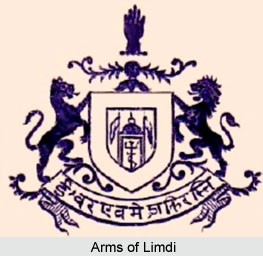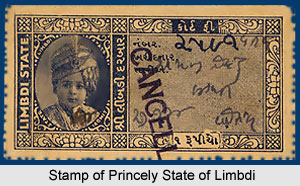 The Princely State of Limbdi, also known as Limri, was one of the well known 9 gun salute states of India that was administered by a native prince under the guidance of the British authorities. The princely state was under the indirect control of the British Empire in India. Limbdi State covered a total area of 343.96 sq miles and comprised of a total population of 44,024 in the year 1941. After the Attachment Scheme of 1943, the area of the princely state increased to 592 sq miles, including the states attached. Limbdi state was situated in the northeastern Kathiawar. The erstwhile native state included 49 villages under its full jurisdiction. The territory also included 34 talukdari villages that were located in the British district of Ahmedabad. The princely state of Limbdi had revenue rights, but no civil or criminal jurisdiction over them.
The Princely State of Limbdi, also known as Limri, was one of the well known 9 gun salute states of India that was administered by a native prince under the guidance of the British authorities. The princely state was under the indirect control of the British Empire in India. Limbdi State covered a total area of 343.96 sq miles and comprised of a total population of 44,024 in the year 1941. After the Attachment Scheme of 1943, the area of the princely state increased to 592 sq miles, including the states attached. Limbdi state was situated in the northeastern Kathiawar. The erstwhile native state included 49 villages under its full jurisdiction. The territory also included 34 talukdari villages that were located in the British district of Ahmedabad. The princely state of Limbdi had revenue rights, but no civil or criminal jurisdiction over them.
The Princely State of Limbdi consisted of one main block of land and 7 remote districts. It was generally bordered by the states of District Thana of Wadhwan and Lakhtar in the north; by the British Collectorate of Ahmedabad in the south and the west; where the territories of Limbdi were territories are inextricably merged with the several states that belonged to Bhoika Thana; by Wadhwan in the west; and by Chuda to the southwest. It was incorporated as a part of the Baroda Agency, which was a sub division of the Western India States Agency. The region was also a part Eastern Kathiawar Agency. Later it became a part of the state of Gujarat.
History of Princely State of Limbdi
 The Jhala Rajputs were ruling family of the princely state of Limbdi. The territory was founded by the second son of Harpaldeo, named Manguji. The native rulers, who held the title of Thakor, initially ruled from Jambu and later Kundni, before Harbhamji I founded the capital at Limbdi during the mid-18th century. This was after the region was seized from the Kathis of Jasdan and Paliad. The succession of the throne was governed by the rule of male primogeniture. The Princely State of Limbdi was honoured as one of the salute states of India with a gun salute of 9 guns. Limbdi state was a Second Class state before the classes were eliminated. It held the 16th rank in order of precedence among the states of Western India, between Rajkot and Dhrol.
The Jhala Rajputs were ruling family of the princely state of Limbdi. The territory was founded by the second son of Harpaldeo, named Manguji. The native rulers, who held the title of Thakor, initially ruled from Jambu and later Kundni, before Harbhamji I founded the capital at Limbdi during the mid-18th century. This was after the region was seized from the Kathis of Jasdan and Paliad. The succession of the throne was governed by the rule of male primogeniture. The Princely State of Limbdi was honoured as one of the salute states of India with a gun salute of 9 guns. Limbdi state was a Second Class state before the classes were eliminated. It held the 16th rank in order of precedence among the states of Western India, between Rajkot and Dhrol.
The courts of the former princely state exercised full civil and criminal jurisdiction. A high court and a representative assembly were set up shortly before the year 1947. the princely state of Limbdi paid tribute to Junagadh. The native ruler of the state of Limbdi, who held the title of Thakor Saheb, was an original member of the Chamber of Princes in his own right. According to the Attachment Scheme of 1943, Limbdi attached 24 talukas from the Wadhwan District and Bhoika Thanas, along with Rai Sankli, which covered a total area of 248 sq miles and comprised of total population 31,004.
After the Indian independence in the year 1947, the last ruler His Highness Thakore Sahib Shri Chhatrasalji Digvijaysinhji, who was the 38th of his line, acceded his state to the newly formed Union of India, also known as Dominion of India.
Rulers of Princely State of Limbdi
The chronology of the rulers of the princely state of Limbdi is discussed as follows:
* Raj Sahib Manguji
* Raj Sahib Madhupal
* Raj Sahib Dhaval
* Thakore Sahib Nagji I
* Thakore Sahib Khetoji Ii
* Thakore Sahib Harbhamji I
* Thakore Sahib Harisinhji
* Thakore Sahib Bhojrajji Iii
* Thakore Sahib Harbhamji Ii
* Thakore Sahib Shri Fatehsinhji
* His Highness Thakore Sahib Shri Sir Jaswantsinhji Fatehsinhji KCIE
* Colonel His Highness Thakore Sahib Shri Sir Daulatsinhji Jashwantsinhji
* His Highness Thakore Sahib Shri Digvijaysinhji Daulatsinhji
* His Highness Thakore Sahib Shri Chhatrasalji Digvijaysinhji



















